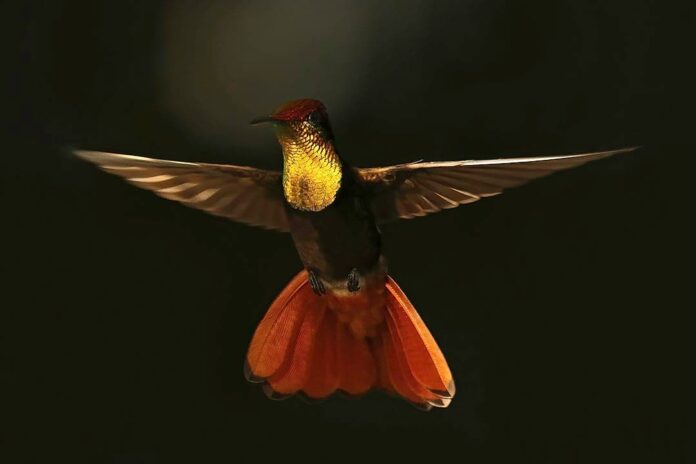We talked about 10 beautiful hummingbird species before, but there are just so many gorgeous ones out there. So I am here to bring you 10 more pretty hummingbird species today. These tiny flappy wings have just the best colorations, maybe this list has more things to see. Feel free to take a look, perhaps you will find more vivid hummingbirds that you will like.
1Cinnamon Hummingbird
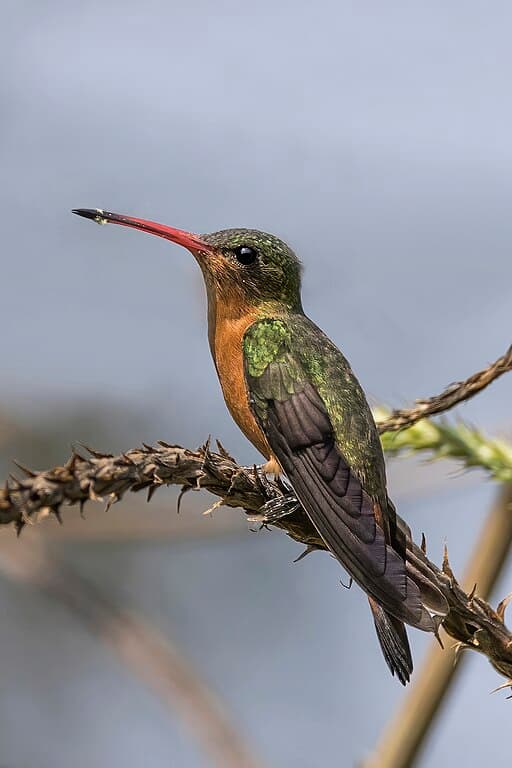
This is one of the smallest hummingbird species, growing to a size of 9.5 to 115 centimeters only. Adult cinnamon hummingbirds have metallic bronze-green upperparts with cinnamon or cinnamon rufous underparts. As for the tail, it is deep cinnamon rufous to rufous chestnut while the wings are dark brownish slate. You can differentiate males and females by their beak colors, males’ bills are red and females’ bills are mostly black with a red base. The adorable cinnamon hummingbirds live in primary and secondary deciduous and semi-deciduous forests and thorn forests. Across their range, these hummingbirds forage from the understory to the mid-story of the forests for flowering plants and insects. Just like other hummingbirds out there, this one also has a long tongue that they use to feed nectar from flowers.
2Green Hermit
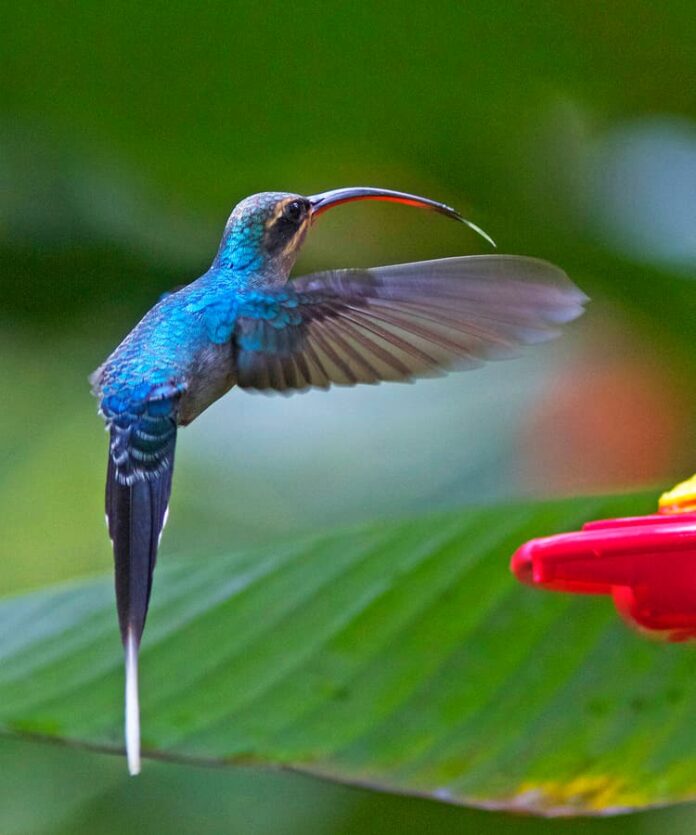
Slightly larger than the cinnamon, the green hermit is 13.5 centimeters with a very eye-catching appearance. Male green hermit hummingbirds are mainly dark green with a blue-green rump. If you look closer, you can see the dark mask through their eyes along with buff stripes above and below. The most fascinating part is the reddish bill that is long and decurved, looking absolutely stunning. Meanwhile, the females are rather sooty gray instead of green with longer bills and tails than that of males.
This beautiful hummingbird species lives in forest undergrowth that is usually near water, and they are fond of hilly areas. They also like primary rainforests and wet premontane forests where food is abundant. These hummingbirds feed on nectar from a wide variety of flowers, and they also take on small insects and spiders. When feeding on nectar, they use this method called “probing” which is the searching for food with the bill. Male green hermit hummingbirds are territorial because they have to retain their lek territory throughout the breeding season every year.
3Hooded Visorbearer
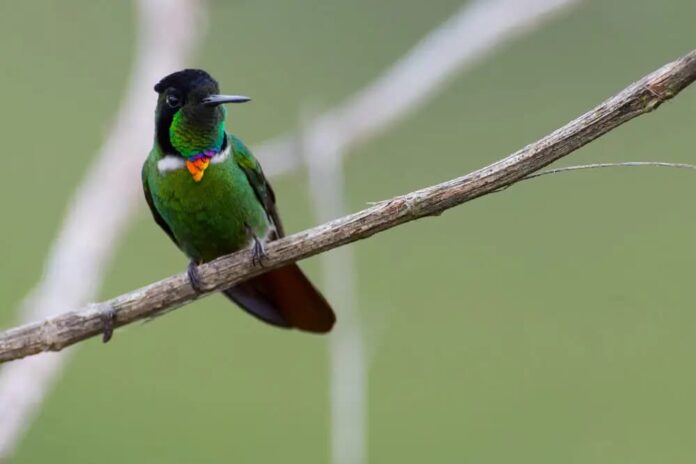
Looks like a hood but is called a crown, this beautiful hummingbird species is born to rule. A male hooded visorbearer has an iridescent bronzy-green overall with a black crown on the sides of his head. His forehead and throat are glittering green that shade to bluish-green at the lower edge. As for females, they are bronzer in color with a green crown and brown sides instead. You can tell a male and female by the color of their throats. A female’s throat is less colorful than a male’s, and she also lacks the iridescence on her forehead. Not to mention males also have a bright iridescent golden-orange spot under the neck, it is so easy to tell.
Hooded visorbearers are endemic to Eastern Brazil, only in the Chapada Diamantina region of Bahia. They inhabit campo rupestre, the open habitats and rocky outcrop areas with harsh climatic conditions and poor soils. They also primarily feed on nectar and occasionally insects just like other hummingbird species out there. Unfortunately, this beautiful hummingbird species is not listed as Near Threatened on the IUCN Red List. Some of their threats are climate change and habitat loss due to the conversion of the campo to pastureland and mining.
4Hyacinth Visorbearer
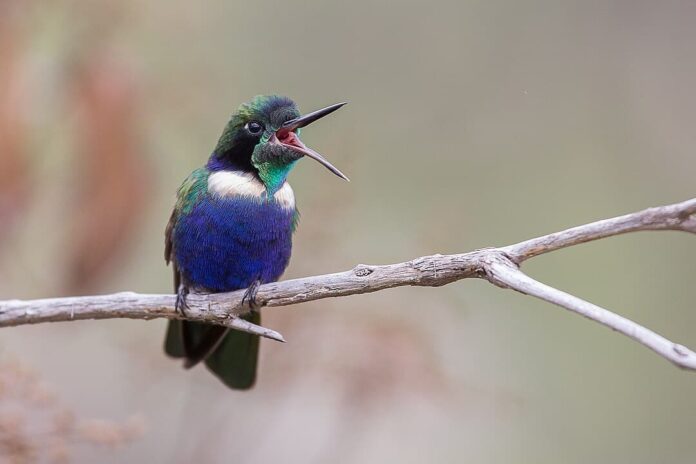
While most hummingbird species have a similar appearance for both sexes, this one is rather different. Male hyacinth visorbearers are not only larger but also heavier than females. On top of that, they also have longer wings and tails than females as well. However, both sexes have short bills; the only feature that both of them share. The males of this species have a shiny golden-green forehead while the rest of the upperparts and tail are bronze-green. Similar to the body, the throat of the bird is also shiny golden-green but with a black edge. The prettiest part is clearly the deep blue belly with purplish-blue ruff on the sides of the neck.
Similar to the hooded visorbearers, this species is also endemic to a specific area in Brazil. You can also find them on the mountaintops of Southeastern Brazil. This small bird only forages 2 to 3 meters above the ground, looking for nectar from various flowering plants. Sometimes it also takes small insects in flight from perch within their territories with groups of flowering plants.
5Minute Hermit
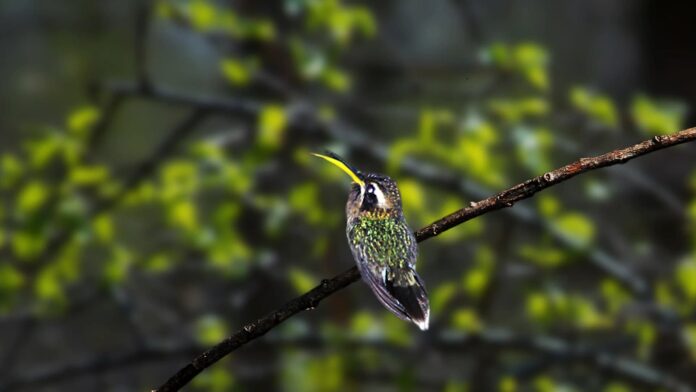
Here you are looking at one of the smallest birds in the world, growing to only 8.4 to 9.2 centimeters. Males have dark iridescent green upperparts and a dark brown throat while females have reddish orange. The distinctive part of the minute hermits is definitely the yellow lower bill that stands out the most. Minute hermit hummingbirds are from Southeaster Brazil from Bahia to Rio de Janeiro, living in the understory of primary or lightly disturbed forests. At the same time, they are trap-line feeders so they visit a circuit of flowering plants for nectar. And while most hummingbirds out there feed on insects for extra nutrients, this one goes for arthropods instead.
6Ruby-Topaz Hummingbird
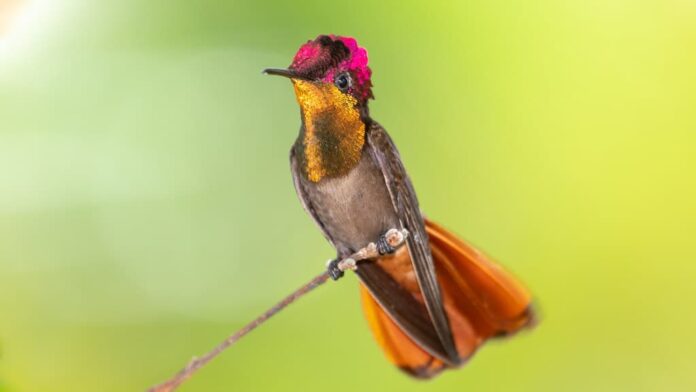
A male has a glowing ruby-red crown, forehead, and nape along with an iridescent orange-yellow throat and breast. The special part is that this brilliant coloration can only be seen under bright light. In poor light conditions, the plumage of the males is dull blackish-brown. Its tail is chestnut with a dark terminal band while the rest of the body is dark brown. As for the female, she has coppery-green upperparts, whitish underparts, and a rufous tail with a broad black terminal band. Both sexes have short and straight black bills as well as black legs and feet.
Their range is across South America as well as Colombia, Suriname, the Guyanas, Tobago, Trinidad, Venezuela, and many other islands. They inhabit agricultural habitats, cultivated areas, forest edges, gardens, open savannas, scrub, and shrubby areas. The nectar that ruby-topaz hummingbirds feed on is from various plants such as cacti, epiphytes, flowering trees, and shrubs. They also consume small insects sometimes, and they defend areas containing flowers with high-energy nectar very aggressively.
7Sparkling Violetear
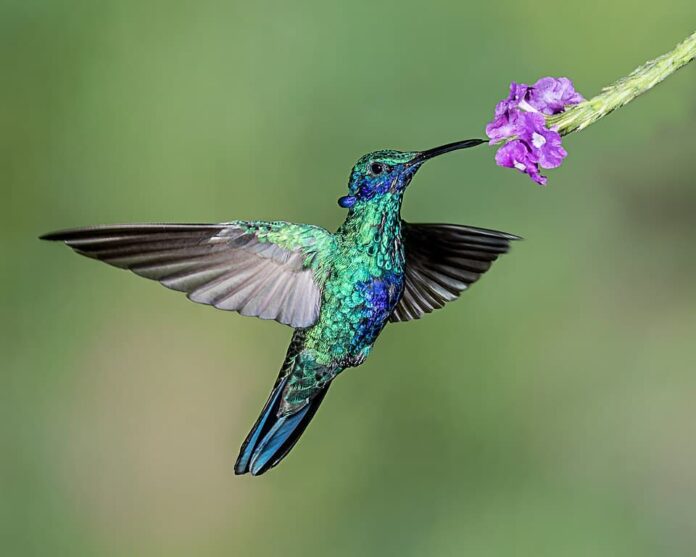
This is the largest hummingbird species on the list so far, reaching a size of 13 to 14 centimeters. A male sparkling violetear has metallic bluish-green upperparts, bluish-violet chin, blue belly, and green underparts. Another distinctive feature is the long erectile bluish-violet plumes that cover its ears along with a metallic green tail with a steely blue band. Females have a similar appearance but often have a white spot behind their eyes. This beautiful hummingbird species inhabits a wide range of open landscapes such as city parks, gardens, subtropical and temperate forest edges, and woodland. They feed on nectar from flowering plants, and they also visit local feeders for some sugar water or drink out of bird baths.
8Violet Sabrewing
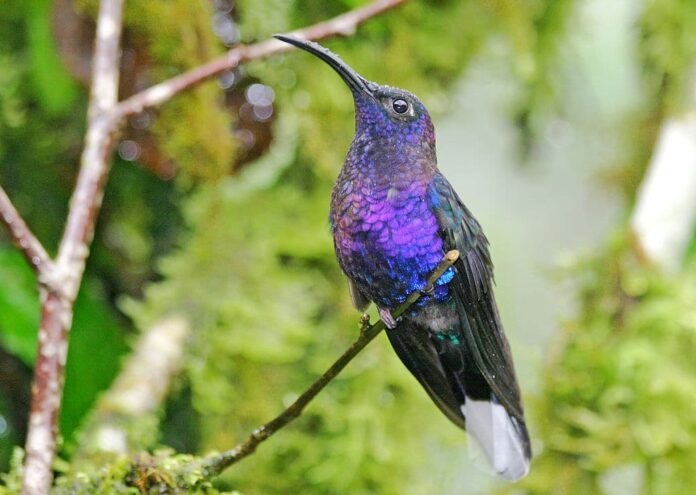
And here we have one of the largest and most beautiful hummingbird species, the largest hummingbird in Central America and Mexico actually. A violet sabrewing hummingbird can be as big as 15 centimeters, and their coloration is rather fascinating. Males have a dusky crown with a bluish-green gloss while the face, nape, upper back, and underparts are metallic violet blue. As for females, they have a dusky crown and metallic green to bronze-green upperparts with a bluish-green rump. Along with that, they have violet-blue throats while the underparts are mostly gray with a whiter belly and metallic green spots.
Violet sabrewings live in areas around streams, disturbed wooded areas, and old second-growth, montane forest edge, and understory, ravines. They feed on nectar by trap-lining, and they visit a circuit of flowering plants in an area where they defend. More than that, they also often forage in banana plantations as well since banana flowers are among their favorites.
9White-Necked Jacobin Hummingbird
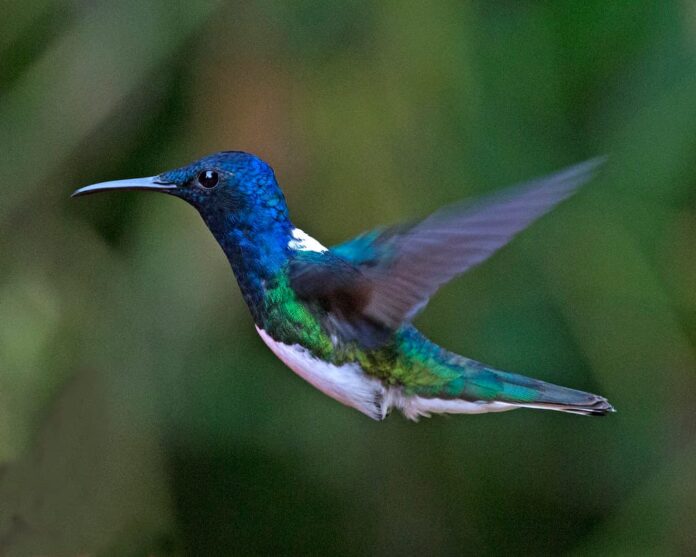
Just another average hummingbird with a stunning beauty that truly belongs to the list of beautiful hummingbird species. Growing to a size of 11 to 12 centimeters, and males and females have a very different appearance. Males have a dark blue head and chest along with white belly and tail with black tips. They also have a white band on the nape that separates the blue head from their bright green back. Meanwhile, females have green upperparts, a blue-green throat and breast with white scales, a white belly, and a green tail with blue end.
The most unique thing about this hummingbird species is that females tend to develop to look more like males now. It is more of a mimicking male appearance with the male’s plumage but not their behavior. Some research shows that females with male-like plumage suffer less aggression from males compared to females with regular female plumage. That also means females can hang out longer at feeding areas so the mimicry helps them to dodge bullies while getting better access to food. When it comes to feeding, the white-necked jacobin hummingbirds usually feed on nectar from flowers of tall trees. At the same time, they also frequently visit epiphytes, Heliconia plants, and shrubs as well.
10Wine-Throated Hummingbird
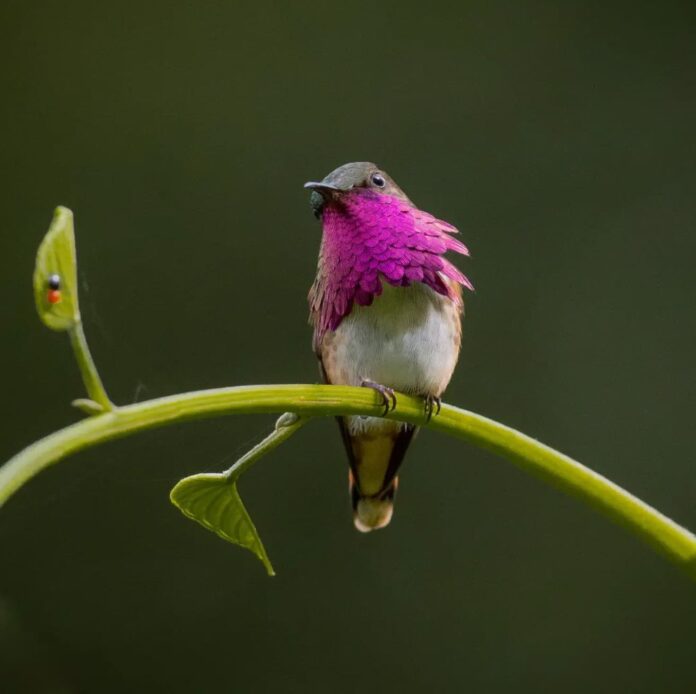
The picture says it all about how it got its name. Small but so pretty, a wine-throated hummingbird is one of a kind. It reaches the size of 6.5 to 7 centimeters, and both sexes have a very similar appearance. Males have green upperparts with glittering rose-pink gorget with violet highlights that definitely catch our eyes. The flanks of the birds are a mix of cinnamon and green while the rest of the underparts are whitish. Females also have green upperparts but their chin and throats are white with many dusky spots. They have white upper breast, a whitish belly while the flanks and under tail coverts are cinnamon. These hummingbirds inhabit montane landscapes such as clearings, edges, and interiors of semi-humid to humid pine-oak and evergreen forests. And just like other hummingbirds, this one also feeds on nectar as well as small arthropods.
Related Post: Beautiful Hummingbird Species Part I

